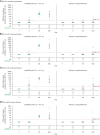A Phase 1/2a Study Evaluating Safety and Immunogenicity of Ad26.RSV.preF in RSV-seronegative Toddlers Aged 12-24 Months
- PMID: 39220658
- PMCID: PMC11365064
- DOI: 10.1093/ofid/ofae453
A Phase 1/2a Study Evaluating Safety and Immunogenicity of Ad26.RSV.preF in RSV-seronegative Toddlers Aged 12-24 Months
Abstract
Background: Respiratory syncytial virus (RSV) causes serious illness in children. The Ad26.RSV.preF vaccine candidate was immunogenic with acceptable safety in a phase 1/2a study of RSV-seropositive children. Here, we assessed its safety and immunogenicity in RSV-seronegative children.
Methods: In this randomized, observer-blinded, placebo-controlled, phase 1/2a study (NCT03606512; https://www.clinicaltrials.gov/ct2/show/NCT03606512), RSV-seronegative toddlers aged 12-24 months received Ad26.RSV.preF (2.5 × 1010 viral particles) or placebo on days 1, 29, and 57 (a meningococcal vaccine [Nimenrix] could substitute for day 57 placebo). Primary endpoints were solicited local and systemic adverse events (AEs; 7 days after each vaccination), unsolicited AEs (28 days postvaccination), and serious AEs (first vaccination until study end). Participants were monitored for RSV-respiratory tract infection to assess infection rates and for severe RSV-lower respiratory tract infection as an indication of enhanced disease. RSV-A2 neutralizing, RSV (A and B) preF binding, and RSV postF immunoglobulin G-binding antibodies were evaluated on days 1 (predose), 8, and 85, and after RSV season 1.
Results: Thirty-eight participants were enrolled and vaccinated (Ad26.RSV.preF, n = 20; placebo, placebo/Nimenrix, n = 18). Solicited AEs were more common following Ad26.RSV.preF than placebo; most were mild/moderate. No vaccine-related serious AEs were reported. Five of 19 participants receiving Ad26.RSV.preF and 2/18 receiving placebo or placebo/Nimenrix had confirmed RSV-respiratory tract infection or RSV-associated otitis media; none were considered severe. At the final season 1 study visit, most Ad26.RSV.preF recipients had ≥2-fold increases from baseline in RSV-A2 neutralizing, RSV A and B preF binding, and RSV postF antibodies.
Conclusions: Ad26.RSV.preF was well tolerated and immunogenic in RSV-seronegative toddlers.
Keywords: adenovirus serotype 26; pediatric vaccination; respiratory syncytial virus; respiratory syncytial virus vaccine.
© The Author(s) 2024. Published by Oxford University Press on behalf of Infectious Diseases Society of America.
Conflict of interest statement
Potential conflicts of interests. J. M. L.'s employer, Dalhousie University, received funding from Janssen to complete this study; J. M. L.'s employer has received research grants from Pfizer, GSK, Merck, and Moderna to conduct clinical trials to prevent RSV. T. M. N. has been a data safety monitoring board member for vaccine studies conducted by Moderna, Clover, Novavax, CSL Seqirus, Arcturus, and SK Bioscience Korea; T. M. N. has received payment for advisory roles on vaccines from AstraZeneca, Moderna, MSD, Sanofi, CSL, and Pfizer; and T. M. N.'s employers, University of Melbourne and MCRI, have received funding to contribute to clinical trials sponsored by Moderna, Iliad, Dynavax, MSD, Sanofi, CSL Seqirus, and Pfizer. M. R. was employed by Tampere University (currently Finnish Vaccine Research Ltd.), which carries out clinical vaccine trials for Janssen and several other vaccine manufacturers. P. C. R.'s employer, University of Western Australia, has received research funding for RSV clinical trials, for this study from Janssen and from Novavax, Merck, AstraZeneca, Pfizer, and GSK; for investigator-led research from Merck and Sanofi; and for P. C. R.'s involvement in advisory boards from Merck, Pfizer, GSK, Sanofi, and Novavax. P. C. R. is also a member of the ReSViNET Board, which is an international advocacy group for RSV awareness, treatment, and prevention. N. R. F. received speaker fees from Sanofi, Novartis, AstraZeneca, GSK, AbbVie, Chiesi, Viatris, Danone, and Pfizer; and received research grants from AstraZeneca, Viatris, Sanofi-Regeneron, Janssen, Eurofarma, and Vertex. W. H., S. P. H. v. d. B., K. W., and N. S. are employees of Janssen Vaccines & Prevention B.V. and may own stock or stock options. E. O. formerly worked at Janssen Infectious Diseases as a consultant. J. W. D. is an employee of Janssen Biologics Europe. G. V. G. and W. v. D. are employees of Janssen Research & Development. A. R. B., E. H., and B. C. are former employees of Janssen Vaccines & Prevention B.V.
Figures




Similar articles
-
Immunogenicity and safety of different dose levels of Ad26.RSV.preF/RSV preF protein vaccine in adults aged 60 years and older: A randomized, double-blind, placebo-controlled, phase 2a study.Vaccine. 2024 Dec 2;42(26):126273. doi: 10.1016/j.vaccine.2024.126273. Epub 2024 Sep 13. Vaccine. 2024. PMID: 39276619 Clinical Trial.
-
Phase 1/2a Safety and Immunogenicity of an Adenovirus 26 Vector Respiratory Syncytial Virus (RSV) Vaccine Encoding Prefusion F in Adults 18-50 Years and RSV-Seropositive Children 12-24 Months.J Infect Dis. 2022 Dec 28;227(1):71-82. doi: 10.1093/infdis/jiac407. J Infect Dis. 2022. PMID: 36259542 Free PMC article. Clinical Trial.
-
Efficacy and Safety of an Ad26.RSV.preF-RSV preF Protein Vaccine in Older Adults.N Engl J Med. 2023 Feb 16;388(7):609-620. doi: 10.1056/NEJMoa2207566. N Engl J Med. 2023. PMID: 36791161 Clinical Trial.
-
A Randomized, Double-Blind, Placebo-Controlled, Phase 1 Study to Evaluate the Safety, Reactogenicity, and Immunogenicity of Single Vaccination of Ad26.RSV.preF-Based Regimen in Japanese Adults Aged 60 Years and Older.Influenza Other Respir Viruses. 2024 Jun;18(6):e13336. doi: 10.1111/irv.13336. Influenza Other Respir Viruses. 2024. PMID: 38880785 Free PMC article. Clinical Trial.
-
Immunogenicity and safety of Ad26.RSV.preF/RSV preF protein vaccine at predicted intermediate- and end-of-shelf-life as an evaluation of potency throughout shelf life.Hum Vaccin Immunother. 2024 Dec 31;20(1):2344970. doi: 10.1080/21645515.2024.2344970. Epub 2024 May 23. Hum Vaccin Immunother. 2024. PMID: 38783590 Free PMC article. Clinical Trial.
Cited by
-
Preventing RSV Infection in Children: Current Passive Immunizations and Vaccine Development.Pathogens. 2025 Jan 21;14(2):104. doi: 10.3390/pathogens14020104. Pathogens. 2025. PMID: 40005481 Free PMC article. Review.
-
Pediatric antibiotic use associated with respiratory syncytial virus and influenza in the United States, 2008-2018.medRxiv [Preprint]. 2025 Mar 26:2025.03.25.25324633. doi: 10.1101/2025.03.25.25324633. medRxiv. 2025. Update in: J Infect Dis. 2025 Jun 07:jiaf309. doi: 10.1093/infdis/jiaf309. PMID: 40196269 Free PMC article. Updated. Preprint.
References
Associated data
LinkOut - more resources
Full Text Sources
Medical

